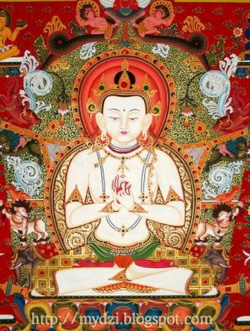Mahavairochana Sutra
Mahāvairocana-sūtra, ( Sanskrit: “Great Illuminator Sūtra”: ) Japanese Dainichi-kyō, text of late Tantric Buddhism and a principal scripture of the large Japanese Buddhist sect known as Shingon (“True Word”).
The text received a Chinese translation, under the title Ta-jih Ching, about ad 725, and its esoteric teachings were propagated a century later in Japan by Kūkai. These teachings, which have been called cosmotheism, centre upon Mahāvairocana (in Japanese,
Dainichi Nyorai), the supreme cosmic buddha, whose body forms the universe.
Through elaborate mystic rituals with a distinctly Indian flavour (even involving certain Hindu deities), one is led to realize that all one’s thoughts, words, and actions are in reality Mahāvairocana’s.
The Mahavairocan-abhisambodhi-vikurvit-adhisthana-vaipulya-sutra was translated into Chinese by Subhakarasimha and I-hsing in A. D. 725 in the Ta-fu-hsien monastery at Tung-tu. Its Chinese title is: Ta-p'i-lu-che-na-ch'eng-fo shen-pien Chia-ch'ih ching. in Japanese pronunciation it reads: Daibirushana-Jobutsu-jimben-kaji-kyo (T848).
This title was translated by Nanjio as "Sutra on Mahavairocana's becoming Buddha and the supernatural formula called yugandhara (? Lit. adding-holding)" (Nj 530).
The terms can now be clarified with the help of the Sanskrit title preserved in the Tibetan Kanjur:
becoming Buddha (jobutsu) = abhisambodhi supernatural formula (jimben) = vikurvita yugandhara (lit. adding-holding) (kaji) = ([[[adhisthana]])].
The Tibetan translation was done by Silendrabodhi and Dpal-brtsegs under the title:
Rnam-par-snan-mdzad-chen-po mnon-par-rdzogs-par-byan-chub-pa rnam-par-sprul-pa byin-gyis-rlob-pa- sin-tu-rgyas-pa mdo-sdehi dban-pohi rgyal-po zhes-bya-bahi chos-kyi-rnam-grans, a translation of the original Sanskrit title:
Mahavairocan-abhisambodhi-vikurvit-adhisthana-vaipulya-sutrendraraja nama dharma-paryaya.
In the Chinese text certain passages echo the word sutrendra-raja.
It is noteworthy that the Enlightenment of Vairocana is abhisambodhi with the prefix abhi-in the sense of intensifying the action implied in the basic word Bodhi.
It denotes the highest enlightenment, that is, a more evolved concept of Bodhi. Abhisambodhi is specifically applied to Vairocana of the carya-tantras.
He is the Abhisambodhi-Vairocana, in contradistinction to the Vajradhatu-Vairocana.
The reconstruction of the Chinese Hung-kuang-hsien-yao-p'u-ti-fo as Vairocanabhisambodhi by Walter Eugene Clark (Two Lamaistic Pantheons 1937:II. 150/5M5) has to be corrected to Abhisambodhi-Vairocana.
In the Sino-Japanese tradition the new tern Garbhadhatu-Vairocana was coined for him. {{E}
